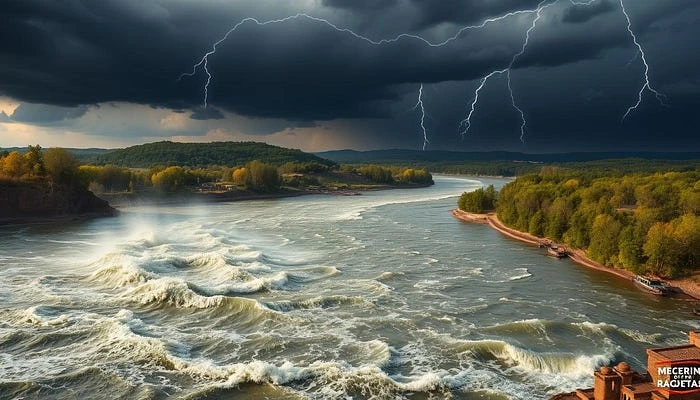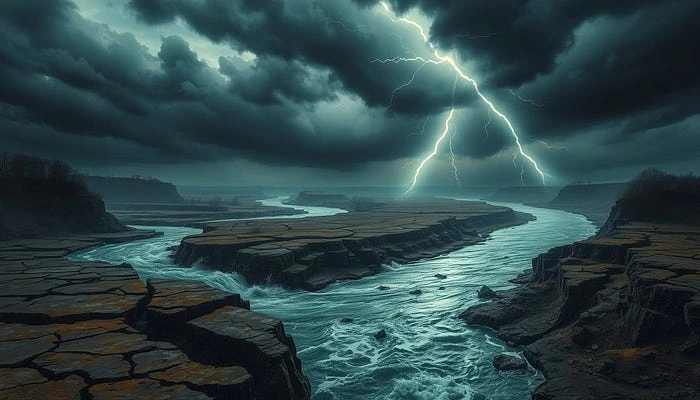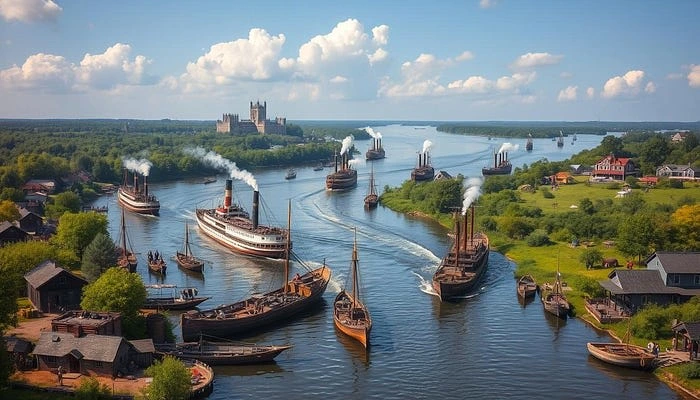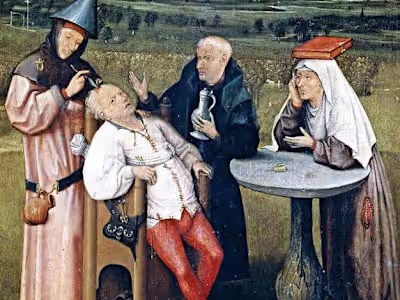Blog Post: 1811 New Madrid Quake: Mississippi Runs Backwards
1811 New Madrid Quake: Mississippi Runs Backwards

10 min read
In American history, a remarkable event happened in 1811. The mighty Mississippi River, the nation’s lifeblood, flowed upstream for hours. This was due to powerful earthquakes around New Madrid, Missouri. The quakes caused widespread destruction and changed the landscape forever.

The 1811 New Madrid earthquake was a major seismic event in American history. It showed the power of geological processes and tectonic plate movements. As the Mississippi River flowed upstream, eyewitnesses were amazed. Their stories vividly describe the incredible force of nature that day.
Key Takeaways
The Mississippi River briefly reversed course in 1811 due to a series of powerful earthquakes in the New Madrid region.
The 1811 New Madrid earthquake was one of the most significant seismic events in American history.
The river’s reversal left eyewitnesses in awe, and their accounts provide a glimpse into the incredible force of nature.
The event shaped the understanding of geological processes and tectonic plate movements.
The New Madrid earthquakes and the river’s reversal are important events in American history that continue to fascinate and inspire.
The Day the Mississippi River Ran Backwards: The 1811 New Madrid Earthquake
The 1811 New Madrid earthquake is a standout in American history. It shook the Midwest and made the Mississippi River flow backward. This incredible sight left many in awe.
The New Madrid earthquakes happened from December 1811 to February 1812. The first quake on December 16th, 1811, was a 7.5 magnitude. It was so strong that it made the Mississippi River flow backward, as many saw and wrote about.
“The Mississippi River seemed to run backwards for a while.” — Eyewitness account from the 1811 New Madrid earthquake
The earthquake’s power was immense. It created temporary waterfalls and changed the river’s course. New islands even formed in the Mississippi. People said the river was “boiling, bubbling, and hissing” as it flowed backward.
The Mississippi River’s reversal shows the New Madrid earthquakes’ incredible power. This event still amazes historians, geologists, and the public. It reminds us of nature’s raw power to change landscapes in unexpected ways.
Seismic Activity and Tectonic Plates
The New Madrid earthquakes in 1811–1812 were caused by deep geological forces. Seismic activity, driven by tectonic plate movement, is key to earthquakes.
Fault Lines and Earthquake Zones
The New Madrid area is on major fault lines. Here, the North American plate meets others. These fault lines are weaknesses in the Earth’s crust.
When plates move, they release seismic energy as earthquakes. The New Madrid Seismic Zone is especially prone to these events.
Measuring Earthquake Intensity
Earthquake intensity is measured by the Moment Magnitude Scale. It shows the energy released.
The 1811–1812 New Madrid earthquakes were very powerful, with magnitudes from 7.0 to 8.0.
Depth and the type of rock and soil also affect the quake’s impact and damage.
Understanding the Earth’s crust is key to knowing the New Madrid earthquakes. These disasters remind us of our planet’s dynamic and unpredictable nature.
The New Madrid Earthquakes of 1811–1812
In the early 19th century, a series of powerful earthquakes hit the central United States. These are known as the New Madrid earthquakes. They happened between 1811 and 1812 and are a major part of American history.
The first big quake was on December 16, 1811. It had a magnitude of 7.7 on the Richter scale. It hit near New Madrid, Missouri, along the Mississippi River. Then, two more strong quakes followed on January 23 and February 7, 1812, with magnitudes of 7.5 and 7.7.
The new madrid earthquakes were incredibly powerful. People said the ground rolled like waves, trees and buildings fell, and the Mississippi River flowed backward. The earthquakes damaged a huge area, causing:
Widespread destruction of homes, businesses, and infrastructure
Landslides and soil liquefaction that altered the landscape
Disruption of steamboat and ferry traffic on the Mississippi River
Significant loss of life, though the exact number is unknown
The New Madrid earthquakes of 1811–1812 show the power of seismic activity and natural disasters. They remind us of the need for preparedness and risk management against such catastrophic events.
“The whole country was convulsed, the earth was in fearful motion, the trees were waving like the billows of the sea, the banks of the river were falling in, the steamboat was rolled from side to side, and seemed every moment ready to turn over.”
Eyewitness account of the 1811 New Madrid earthquake
Eyewitness Accounts of the River’s Reversal
The Mississippi River flowed backwards during the New Madrid earthquakes of 1811–1812. This was a terrifying sight for those who saw it. They were amazed by the power of geological events that seemed to break all rules.
A riverboat captain saw this and was shaken: “The river started running backwards, with a force and rage I had never seen. Huge waves crashed against the shore, tearing down trees and buildings in its path. It was as if the very earth had opened up and swallowed the river whole, only to spit it back out in a violent display of natural disasters.”
“The river started running backwards, with a force and rage I had never seen. Huge waves crashed against the shore, tearing down trees and buildings in its path. It was as if the very earth had opened up and swallowed the river whole, only to spit it back out in a violent display of natural disasters.”
A local farmer also witnessed the river reversals and was both amazed and terrified: “I watched in disbelief as the water rushed upstream, churning and foaming. The surface of the river seemed to boil, and the sound was deafening. I had never experienced anything like it in my life, and I pray I never do again.”
These eyewitness accounts show the incredible force of nature during the New Madrid earthquakes. They remind us of the power of geological events that can change our world.
Geological Impacts and Lasting Effects
The New Madrid earthquakes of 1811–1812 had a big impact on America. They changed the landscape in ways that are still seen today. Rivers changed course, new lakes formed, and the terrain was altered.
One big change was Reelfoot Lake in Tennessee. It was created when the ground sank due to the earthquakes. Other signs of the quakes include sand blows and fissures.
The New Madrid area is still a worry for scientists and disaster teams. It’s prone to seismic activity. This means big earthquakes could happen again, posing a risk to the area.
The New Madrid earthquakes are a big part of American history and geological events. Knowing about these lasting effects helps us understand the area’s challenges and risks.
Natural Disasters in American History
The United States has seen many natural disasters, like earthquakes, hurricanes, wildfires, and floods. The New Madrid earthquakes of 1811–1812 are a big part of American history. They changed the country’s landscape forever.
Comparing the New Madrid Quakes to Other Events
The New Madrid earthquakes were big, but they’re not the only major seismic events in American history. Other big ones include the 1906 San Francisco earthquake, the 1964 Alaskan earthquake, and the 1989 Loma Prieta quake.
Event/Location/Magnitude/Casualties
New Madrid Earthquakes (1811–1812)/New Madrid, Missouri/Estimated 7.0–8.0/Minimal (no official count)
San Francisco Earthquake (1906)/San Francisco, California/7.9/3,000 (estimated)
Alaskan Earthquake (1964)/Anchorage, Alaska/9.2/139
Loma Prieta Earthquake (1989)/Santa Cruz, California/6.9/63
Even though the New Madrid earthquakes were less known than some West Coast quakes, they’re still a big part of American history. They show how natural disasters can change the country’s landscape and society.

“The Mississippi River actually flowed backwards for several hours, and large areas of land were permanently changed.”
The New Madrid quakes were special, like when the Mississippi River flowed backwards. They remind us of the huge forces at work during seismic activity. And how geological events can deeply affect the American landscape.
Preparedness and Risk Management
Natural disasters like the New Madrid earthquakes show how vital preparedness and risk management are. Communities and authorities work hard to lessen the damage from such disasters. They aim to keep people safe and strong.
Being ready for earthquakes involves many steps. First, early warning systems send alerts quickly. This lets people act fast and find safe places. Also, buildings and bridges are made stronger to handle earthquakes.
Managing risks from disasters has gotten better too. There are detailed plans for emergencies. These plans cover how to evacuate, search for people, and help after a disaster. Regular drills help everyone know what to do.
Preparedness Measure/Description
Early Warning Systems/Advanced technology that detects seismic activity and sends alerts to the public, enabling them to take immediate action.
Infrastructure Reinforcement/Retrofitting and strengthening buildings, bridges, and other critical structures to withstand the impact of earthquakes.
Emergency Response Planning/Comprehensive plans outlining procedures for evacuation, search and rescue, and disaster relief efforts.
Community Engagement/Educating the public on earthquake preparedness, fostering a culture of resilience, and promoting individual readiness.
By focusing on being ready and managing risks well, areas at risk like the New Madrid Seismic Zone can be more resilient. These steps help save lives and protect the economy and society.
“Preparation through education is less costly than learning through tragedy.” — Max Mayfield, Former Director of the National Hurricane Center
Riverways and the Mississippi’s Role
The Mississippi River has always been key for trade and travel in the U.S. It runs through the heart of America, helping the country grow economically and culturally. Since early European times, it has helped move goods, people, and ideas across the land.
The Mississippi’s Importance in Commerce and Transportation
The Mississippi River basin covers over 40% of the U.S. It’s a major spot for trade and travel. It connects the Midwest’s farms to the Gulf Coast’s cities and ports. Barges on the river and its tributaries make it easy and cheap to move things like grain, coal, and goods.
Commodity/Annual Volume (Millions of Tons)
Grain/60
Coal/120
Chemicals/55
Petroleum Products/45
The Mississippi’s role in trade and travel has lasted, even with natural disasters like the New Madrid earthquakes. These earthquakes changed the river’s flow, showing how nature can change history.
Today, the Mississippi is still crucial for the U.S. It helps move goods and supports key industries. As the U.S. deals with natural disasters and climate change, the Mississippi’s role will only get bigger.

Conclusion
The 1811 New Madrid earthquakes and the Mississippi River’s flow reversal are amazing. We’ve looked at how earthquakes shook the American heartland. We’ve also seen how the river’s flow changed and how the area has been shaped by these events.
The New Madrid earthquakes remind us of nature’s unpredictable power. They show us the importance of understanding new madrid earthquakes, seismic activity, and the mississippi river. This river is key for our country’s trade and travel.
Even though the 1811 quakes are mostly forgotten, their lessons are still with us. The natural disasters that have shaped american history and the ongoing geological events teach us to prepare and respect our planet. Let’s stay alert, strong, and thankful for the wonders around us.
FAQ
What was the 1811 New Madrid earthquake and why did it cause the Mississippi River to run backwards?
The 1811 New Madrid earthquake was a series of powerful quakes in the New Madrid Seismic Zone. This area is near New Madrid, Missouri. The quakes were so strong they made the Mississippi River flow backwards, a rare event.
The earthquakes disrupted the riverbed and tectonic plates. This forced the water to flow backwards for a time before it went back to normal.
How did the New Madrid earthquakes impact the surrounding region?
The New Madrid earthquakes of 1811–1812 were devastating. They caused widespread destruction, including collapsed buildings and changes to the landscape. The Mississippi River running backwards was a terrifying sight.
These quakes also created new lakes and made some waterways disappear. The area was forever changed, facing ongoing earthquake risks.
What role do tectonic plates and fault lines play in causing earthquakes like the New Madrid quakes?
Earthquakes happen when tectonic plates move and collide along fault lines deep in the Earth. The New Madrid Seismic Zone is a complex area where several plates meet. The pressure built up here can suddenly release, causing powerful earthquakes.
Understanding these geological factors helps us assess earthquake risks. It’s key for keeping vulnerable areas safe.
How are the intensity and magnitude of earthquakes measured?
We measure earthquake intensity and magnitude using standardized scales. The Richter Scale shows the quake’s total energy released. The higher the value, the stronger the quake.
The Modified Mercalli Intensity Scale measures the shaking and damage at a specific location. It ranges from I (barely perceptible) to XII (total destruction). Together, magnitude and intensity give a full picture of an earthquake’s impact.
What were some of the other notable natural disasters in American history, and how do they compare to the New Madrid earthquakes?
The U.S. has seen many significant natural disasters, like hurricanes and volcanic eruptions. But the New Madrid earthquakes of 1811–1812 were unique. They were as powerful as the 1906 San Francisco earthquake and made the Mississippi River flow backwards.
While other disasters were destructive, the New Madrid quakes showed nature’s incredible force. They dramatically changed the landscape.
How can communities prepare for and mitigate the impact of natural disasters like the New Madrid earthquakes?
Communities must prepare for natural disasters to stay safe. This means investing in strong buildings and infrastructure. It also involves having early warning systems and evacuation plans.
Regular drills and education help people understand risks and respond correctly. Scientists, government agencies, and local communities must work together. This is crucial for reducing the impact of future disasters.
How has the Mississippi River and its riverways impacted the history and development of the United States?
The Mississippi River has been vital for commerce, transportation, and culture in America. It’s a major waterway that helped the nation grow economically and industrially. The river’s flow was disrupted during the New Madrid earthquakes, showing its power.
Today, the Mississippi River remains key for industries and communities. Its reliable flow supports a wide range of activities and livelihoods.

0 Followers
Like this project
Posted Oct 10, 2024
Created a blog post of an article about the 1811-1812 New Madrid Earthquakes that caused the Mississippi River to run backward.
Likes
0
Views
0
Tags



